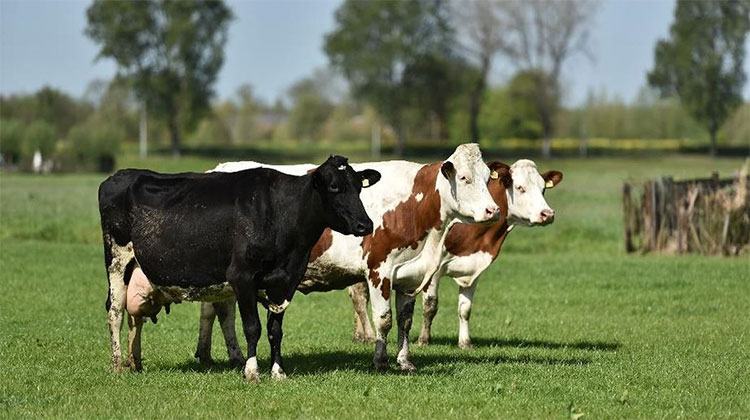10,000 years of human experience drinking cow's milk
Mankind is familiar with drinking cow's milk for millennia thanks to the biological evolution of the body and progress in animal domestication.
Compared to human history, drinking milk is a relatively new habit. 10,000 years ago, very few people drank milk, or if they drank it only on rare occasions.The first people to drink milk were farmers and pastors in Western Europe who lived with domesticated animals, including cows. Today, drinking milk is a common practice in Northern Europe, North America and many Asian countries.
Due to many biological causes, it is strange for humans to drink animal milk. Milk contains lactose , different from sugar in fruits and other sweets. As a child, our bodies produce an enzyme, especially lactase , that helps digest lactose in breast milk. By weaning, most of us stop secreting lactase. Without this enzyme, humans cannot fully digest lactose in milk . Therefore, if you drink too much milk, we may have flatulence, cramps or even diarrhea. In other mammals such as cows, cats or dogs, no adult is still lactase.

Cow's milk is a valuable source of nutrition for humans, although our bodies are not designed to digest it.(Photo: TT).
The first Europeans to drink milk had "deflated" a lot to waste steam in their bodies. Then, because of the evolutionary process, some people started to keep the lactase enzyme intact as adults, helping them to drink milk without side effects. This is the result of a DNA mutation that regulates the activity of lactase.
"For the first time humans recorded the emergence of sustainable lactase about 5,000 years ago in Southern Europe and spread to Central Europe about 2,000 years later," Laure Ségurel , associate professor at the Paris Museum of Humanity (France). , co-authored a scientific paper on sustainable lactase in 2017, said. Sustainable Lactase has evolved favorably and is now extremely popular in some populations. For example, in the Nordic region, more than 90% of the population has sustainable lactase.
People without a stable lactase enzyme can still eat small amounts of lactose without shedding the disease. To make it easier to digest milk, our ancestors came up with a way to make milk into butter, yogurt, ice cream and cheese. Hard cheeses such as cheddar have about 10% less lactose than milk.
So why do people start drinking milk? Dallas Swallow genetics professor from the University of London (UK) said that because of the fat-rich milk, protein, sugar and micronutrients like calcium and vitamin D. In addition, milk is also a source of clean water. The Dutch even drink cow's milk instead of water.
Associate Professor Segurel speculated that drinking cow's milk could have benefits other than nutritional value. Breeders are often exposed to animal diseases, including anthrax and cryptosporidium (causing digestive and respiratory problems). Therefore, drinking cow's milk will provide antibodies against these pathogens. In humans, the protective effect of milk is one of the reasons for breastfeeding.
In recent years, people have the opposite trend to abandon cow's milk. In November 2018, how did the article " We Love Milk Cow" published in Guardian describing the rapid increase of oatmeal and nut milk companies and the traditional milk outlook facing the big battle.
However, statistics show other facts. The 2018 report of the Milk Research Network (IFCN), the global total milk production increased continuously since 1998 to meet user demand. In 2017, there were 864 million tons of milk produced in the world. IFCN experts predict milk demand will increase 35% by 2030 to 1.168 million tons.
Milk types are unlikely to replace cow's milk, at least for the next decade. Catherine Walker, a Swallow professor and graduate student, said nut milk does not have a nutritional source like cow's milk, best suited for vegetarians and allergic to milk because of its reaction to milk proteins. Research published in January concluded to enhance the health of both humanity and the earth, people need to cut red meat and other products from animals but still should drink a cup of milk every day.
According to Ms. Ingrid Mol, director of research and development of a milk production group in the Netherlands, children should take 400-600ml of cow's milk every day, preferably choose products Organic milk products to understand the origin of products.In the case of traditional hard-to-digest milk, you can choose non-lactose milk or replace it with yogurt, cheese.
In addition, the United Nations Food and Agriculture Organization urges people in countries to feed many non-traditional dairy animals such as camels, so that they will still benefit from milk when cow's milk is not available. or too expensive.
Cow's milk will probably not disappear from human life in the near future.
- Transgenic dairy cows produce human milk
- Cow 'for human milk'
- Happy hormone injections for cows help make milk more delicious and nutritious
- Genetically modified cows make milk safer
- The reason you feel uncomfortable when drinking milk
- Cows with formal names will give a lot of milk
- Breeding cows for milk is useful for users' health
- How to drink milk many people don't know
- Cowsitis and reproductive cows
- If you want more milk, name it
- Do children necessarily have to drink milk?
- The cause of drinking milk is abdominal pain
 'Fine laughs' - Scary and painful torture in ancient times
'Fine laughs' - Scary and painful torture in ancient times The sequence of numbers 142857 of the Egyptian pyramids is known as the strangest number in the world - Why?
The sequence of numbers 142857 of the Egyptian pyramids is known as the strangest number in the world - Why? History of the iron
History of the iron What is alum?
What is alum?